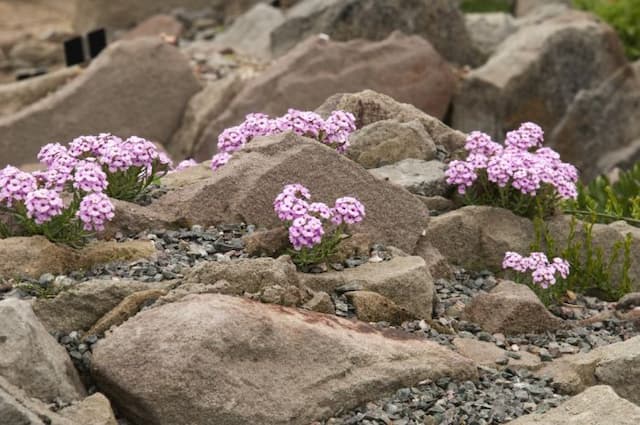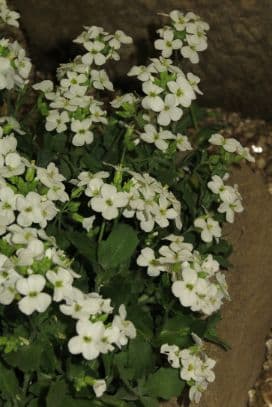Radish Raphanus sativus 'Sparkler'

ABOUT
The Sparkler radish is a popular vegetable known for its vibrant appearance and crisp texture. At first glance, you'll notice its round, plump root which commonly boasts a bright red top that fades into a stark white bottom, giving it a two-toned look much like the traditional image of a radish. The skin of the Sparkler radish is smooth and their size is typically consistent with what you would expect of common radishes. The flesh inside the root is solid white, offering a crisp and juicy bite. Its taste is fresh and slightly spicy but not as peppery as some other radish varieties. Above the soil, this radish variety sends out lush green leaves, which are medium to dark green in color and have a rough, somewhat hairy texture. The leaves are deeply lobed, similar to arugated design, and sprout from the top of the root. This leafy green top is also edible, often utilized in salads or as a cooked green much like spinach or kale. This radish is often grown for its attractive root and may be presented in salads and dishes as a visually appealing element that adds crispness and a zesty flavor. It is a cool-season crop that can be grown in spring or fall and is known for its relatively quick maturation, which makes it a favorite among gardeners wanting a fast harvest.
About this plant
 Names
NamesFamily
Brassicaceae.
Synonyms
Garden Radish, Sparkler White Tip Radish.
Common names
Raphanus sativus 'Sparkler'.
 Toxicity
ToxicityTo humans
Radish, specifically the Raphanus sativus 'Sparkler' variety, is generally considered to be safe for human consumption. In fact, it is commonly eaten around the world as part of various cuisines. There is no widespread evidence to suggest that radishes are toxic to humans, and they are not known to contain any poisonous substances when consumed in usual food amounts. If a person were to eat an exceptionally large quantity of radishes, they might experience stomach discomfort or gas due to the vegetable's high fiber content, but this is not a result of toxicity. In the case of allergies, individuals may experience symptoms such as itchiness, hives, or difficulty breathing, but this is a relatively uncommon response.
To pets
Radish, including the Raphanus sativus 'Sparkler' variety, is not considered to be toxic to pets, including cats and dogs. Pets can sometimes consume small amounts of radish without any adverse effects. However, large amounts might cause some gastrointestinal discomfort due to the radish's fiber content and spicy flavor. Symptoms of gastrointestinal upset could include loose stools or vomiting. Nevertheless, as with any food that is not a regular part of a pet's diet, it is advisable to introduce radishes in moderation and watch for any signs of intolerance or adverse reactions.
 Characteristics
CharacteristicsLife cycle
Biennials
Foliage type
Deciduous
Color of leaves
Green
Flower color
White
Height
1-2 feet (30-60 cm)
Spread
1-1.5 feet (30-45 cm)
Plant type
Herb
Hardiness zones
2-11
Native area
Asia
Benefits
 General Benefits
General Benefits- Edible Parts: The radishes produced by Raphanus sativus 'Sparkler' are edible and are often used in salads and as garnishes due to their crisp texture and peppery flavor.
- Easy to Grow: This plant is known for being easy to cultivate, making it a good choice for novice gardeners or those looking for low-maintenance vegetables.
- Fast Growing: Sparkler radishes have a quick growth cycle, often ready for harvest within 3-4 weeks, providing quick results for gardeners.
- Nutrient-Rich: The radishes contain vitamins and minerals, such as vitamin C, potassium, and fiber, contributing to a healthy diet.
- Garden Pest Control: Growing radishes can help deter some pests from more sensitive plants when used as a companion plant in the garden.
- Soil Improvement: Radishes are known to help break up compacted soil with their roots, improving soil structure and health over time.
- Aesthetic Appeal: The plant adds visual interest to gardens with its vibrant red and white bulbs and green foliage.
- Culinary Versatility: Radishes can be eaten raw, pickled, or cooked, offering a variety of uses in the kitchen.
 Medical Properties
Medical Properties- Digestive aid: Raphanus sativus 'Sparkler' radish has been traditionally used to stimulate digestion and alleviate constipation due to its fiber content.
- Diuretic effect: The diuretic properties of radish may help in flushing out toxins from the kidneys and can aid in urinary disorders.
- Vitamin C source: As a vitamin C-rich food, radishes can contribute to immune system support and may have an antioxidant effect.
- Anti-inflammatory: The plant contains compounds that may exert anti-inflammatory actions, potentially providing relief in inflammatory conditions.
 Air-purifying Qualities
Air-purifying QualitiesThis plant is not specifically known for air purifying qualities.
 Other Uses
Other Uses- Radish 'Sparkler' leaves can be used as a pest-repelling mulch in gardens, due to their strong odor and potential insect-repelling properties.
- The seeds of the radish can be sprouted to create radish sprouts, which can be used in salads, sandwiches, or as a garnish.
- Radishes can also be used as an organic seed tape when dried and glued to paper, allowing for easy spacing and planting in gardens.
- Dye can be extracted from radish roots and used in natural fabric dyeing processes, producing various shades of yellows and oranges.
- Radish 'Sparkler' can serve as a trap crop, luring pest insects away from more valuable crops in the garden.
- Carved radish 'Sparkler' can be used for garnishing and creating attractive culinary presentations.
- The juice from radish 'Sparkler' can be used as a natural cleaning agent for removing rust from metal surfaces.
- Radish leaves can be used as a natural abrasive for cleaning tough dirt and stains from pots and pans without scratching them.
- The radish can be used in educational projects to demonstrate the plant lifecycle from seed to harvest in a relatively short period.
- In compost piles, radish remains can help activate and accelerate the decomposition process due to their high moisture and nutrient content.
Interesting Facts
 Feng Shui
Feng ShuiThe Radish is not used in Feng Shui practice.
 Zodiac Sign Compitability
Zodiac Sign CompitabilityThe Radish is not used in astrology practice.
 Plant Symbolism
Plant Symbolism- Vitality: The vivid red color of the radish is often associated with energy and life force, symbolizing a sprightly vitality.
- Protection: In some cultures, radishes are believed to have protective qualities, warding off evil and negative energies.
- Prosperity and abundance: Due to their rapid growth, radishes symbolize a quick return on investment and can represent abundance and the swift arrival of prosperity.
- Health: Radishes are known for their dietary benefits and healing properties, symbolizing good health and well-being.
- Humility: Though not a grandiose vegetable, radishes represent modesty and simplicity, reminding us of the importance of staying grounded and humble.
 Water
WaterRadishes, specifically the 'Sparkler' variety, should be watered consistently to maintain moist soil without over-saturating it, ideally giving the plant about one inch of water per week. Deep watering once or twice a week is preferable to encourage root growth, and this can be adjusted based on weather conditions with less water needed during rainy periods and more during dry spells. Using a watering can or hose, aim to provide gentle, even coverage, watering at the base of the plants to reduce the risk of leaf diseases. Mulching around the plants can help retain soil moisture and reduce the need for frequent watering.
 Light
LightRadishes, like the 'Sparkler' radish, thrive in full sun, requiring at least six hours of direct sunlight each day for optimum growth. Plant them in a location where they can receive unfiltered sunlight throughout the day, as this will ensure strong root development and a healthy crop. If you live in a particularly hot region, some afternoon shade can help prevent the plants from bolting or becoming stressed by excessive heat.
 Temperature
TemperatureRadishes, including the 'Sparkler' variety, prefer cooler temperatures and can tolerate light frosts, making them ideal for spring and fall planting. They thrive in temperatures between 50°F and 70°F and can survive minimum temperatures of just above freezing. However, prolonged exposure to temperatures above 85°F can stress the plants, leading to bolting and a bitter taste in the mature radishes.
 Pruning
PruningPruning is not typically required for 'Sparkler' radishes, as they are fast-growing root vegetables. The primary care involves thinning the seedlings early in the growing process to allow for proper root development. Remove the weakest seedlings, leaving the strongest to grow to maturity. This thinning should be done when the seedlings are about 1 inch tall.
 Cleaning
CleaningNot needed
 Soil
SoilSparkler radish requires well-drained, fertile soil high in organic matter, with a pH of 5.5 to 6.8. A blend of garden soil, compost, and a balanced fertilizer works well for optimal growth.
 Repotting
RepottingRadishes, including Sparkler radishes, are not typically repotted as they are fast-growing, annual vegetables that are harvested before repotting is necessary.
 Humidity & Misting
Humidity & MistingSparkler radishes are not particularly humidity-sensitive; they thrive in average garden conditions without the need for specific humidity adjustments.
 Suitable locations
Suitable locationsIndoor
Use deep pots with rich soil and ample light to grow Sparkler radish indoors.
Outdoor
Sow Sparkler radish seeds in rich soil, spaced well, in a sunny area.
Hardiness zone
2-11 USDA
 Life cycle
Life cycleRaphanus sativus 'Sparkler', commonly known as the Sparkler radish, begins its life as a seed planted in cool, moist soil, germinating within a few days to a couple of weeks. The seedling emerges with two initial leaves, and as it grows, true leaves develop and form a rosette at the soil surface. The plant then develops a swollen edible root, which can range in color and is typically round or oval-shaped, along with a foliage of larger, rougher leaves that are edible as well. After a few weeks to a few months, depending on conditions, the radish reaches maturity and is ready for harvest. If not harvested and left to grow, the plant will eventually bolt, sending up a flower stalk that produces white or lilac flowers, which will then pollinate and set seed capsules. These seed pods mature, dry out, and release seeds, thereby completing the life cycle and allowing for the next generation of Sparkler radishes to be sown.
 Propogation
PropogationPropogation time
Spring to Summer
The radish variety Raphanus sativus 'Sparkler' is most commonly propagated by seed. Propagation by seed is usually done in the spring or autumn, taking advantage of the cool weather which radishes prefer. To propagate 'Sparkler' radishes, seeds should be sown directly into well-prepared soil that is loose and free of large stones. Sow the seeds approximately 1/2 inch deep (about 1.27 centimeters) and space them an inch apart in rows that are about a foot (30.48 centimeters) apart. As they grow and develop true leaves, thinned seedlings can be eaten as sprouts. Watering should be done consistently but not excessively to maintain moist soil for germination and growth. Radishes are quick growers, with 'Sparkler' going from seed to harvest in just 25 to 30 days.



![Aubrieta [Axcent Light Blue]](/_next/image?url=https%3A%2F%2Fplants-admin.emdemapps.com%2Fimages%2Fplants%2F%2Fimages%2F604b5e7128866.png&w=640&q=75)





